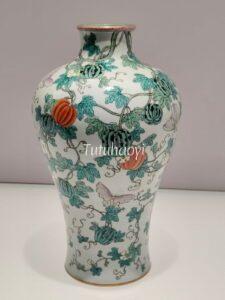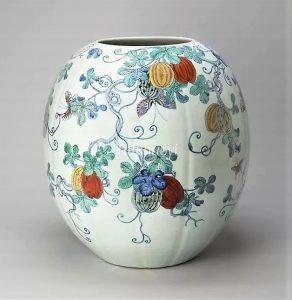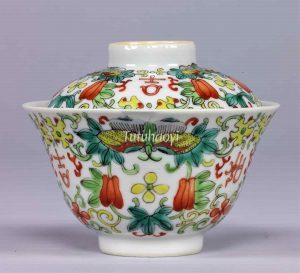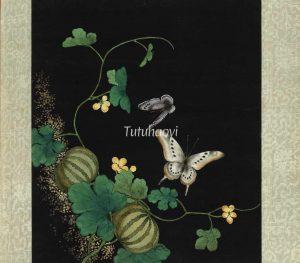May the male line in your family clan continue and flourish (pun picture)
瓜瓞绵绵 (谐音画)
© Tutuhaoyi.com owns the copyright of the description content for the images attached. Quoting all or part of the description content on this page is permitted ONLY IF ‘Tutuhaoyi.com’ is clearly acknowledged anywhere your quote is produced unless stated otherwise. (本页描述内容版权归Tutuhaoyi.com所有,转发或引用需注明 “Tutuhaoyi.com”, 侵权必究, 已注开源信息的条目除外。)
The phrase ‘gua die mian mian 瓜瓞绵绵’ is a variation of a line from a poem in the Classic of Poetry, Shijing 诗经, compiled in China during the period between the 11th to 7th centuries BCE, used as a metaphor for the continuation and flourishing of the family or clan along the male line. The Chinese character ‘gua 瓜’ refers to mature ‘melon’, ‘squash’, ‘gourd’, ‘pumpkin’, ‘cantaloupe’ and the like and the character ‘dié 瓞’ to their young ones. Derived from the classic text, pictorial depictions of melons with spreading vines became a popular subject to wish the family prosperity of the patron. Later, in order to liven the composition, butterflies were added because the character ‘dié 蝶’ for ‘butterfly’ or possibly ‘moth’ makes a pun on ‘dié 瓞’ for ‘small melons’ in the original phrase.
Related motif on the same topic:
Note: this pun picture is to be differentiated from a pictorial allusion May the male line in your family clan continue and flourish in Motifs & Symbols section.
Fig 1: famille rose porcelain vase, Qianlong period (1736–95), Qing dynasty, courtesy of the Shanghai Museum, China
Fig 2: porcelain jar with underglaze blue and overglaze enamelled decoration, 18th century, courtesy of the Art Institute of Chicago
Fig 3: copper lidded jar decorated with polychrome enamels, Qianlong period (1736–95), Qing dynasty, courtesy of the National Palace Museum, Taipei
Fig 4: gilded lacquer box with cover, Qing dynasty (1644–1911), courtesy of the Palace Museum, Beijing, China
Fig 5: amber carving, 18th century, courtesy of the National Palace Museum, Taipei
Fig 6: porcelain snuff bottle with overglaze enamelled decoration, 1800–50, courtesy of Princeton University Art Museum, Object Number y1936-865
Fig 7: famille rose porcelain bowl, Jiaqing period (1796–1820), Qing dynasty, courtesy of Saint Louis Art Museum, Missouri
Fig 8: famille rose porcelain tea cup, Daoguang period (1821–50), Qing dynasty, courtesy of Tokyo National Museum, Japan
Fig 9: head piece with kingfisher feather and jewellery, Qing dynasty (1644–1911), courtesy of the Palace Museum, Beijing
Fig 10: album leaf, ink and colour on silk, Shen Zhenlin (沈振麟 active in 19th century), Qing dynasty (1644–1911), courtesy of the National Palace Museum, Taipei









